B2B marketing is often seen as the boring relative of B2C. But that couldn’t be further from the truth. Business-to-business marketing is more of a challenge because you work with a company or group of stakeholders and the process is more complex. That’s actually what makes it exciting!
But B2B marketers are succeeding in the online space, especially since Covid-19 forced companies to pivot and adapt. The ever-changing digital landscape has offered B2B brands new ways to connect with customers.
With the global B2B ecommerce market projected to be worth nearly $19 billion by 2027, according to an Astute Analytica report, the online space is full of opportunities. This growth is due to a focus on digital experiences, the popularity of specialized B2B online marketplaces, and retail businesses migrating to online operations.
So how can you succeed in the world of B2B marketing? In this blog, we’ll provide you with a B2B marketing 101 that looks at trends, strategies, platforms, and inspiring real-world examples.
What is B2B Marketing?
B2B or business-to-business marketing is the promotion of services or goods to business buyers. It’s about selling to corporate customers rather than individuals and it requires different marketing tactics and strategies.
B2B marketing aims to increase the visibility of a product or service, drive leads and make sales. This can be done by using social media, SEO, content marketing, and many of the digital marketing techniques that are used by B2C marketers.
In recent years influencer marketing has become an important element of B2B marketing while social selling is going from strength to strength on platforms like LinkedIn.
What are the four types of B2B Markets?
There are four types of B2B markets based on the type of business involved and what each offers. These include:
1.Producers - These are companies that create something using your resources such as a restaurant, bakery, or tech solution provider. McDonald’s or Proctor and Gamble would be an example.
2.Resellers - This type of B2B company resells your product or service as it was created as a third-party provider. Examples include retailers and wholesalers like Walgreens or Target.
3.Government - This includes government agencies across the world that buy products and use them. Any national, regional, or local government agency could fall under this type, such as Gov.uk.
4.Institutions - This includes charities, nonprofits like hospitals and churches, along with educational institutionscolleges. Examples include the American Red Cross and Greenpeace.
What is B2C Marketing?
As indicated by its name, business-to-consumer, B2C marketing focuses on marketing to the individual consumer. B2C marketing is seen as more transactional as its goal is to drive a customer to purchase on a site, network or app.
B2B vs B2C Marketing
Most of the time, B2B marketing is driven by logical purchasing decisions, while B2C marketing focuses on emotion-driven purchasing decisions. There is often an overlap between the two types but the difference is significant.
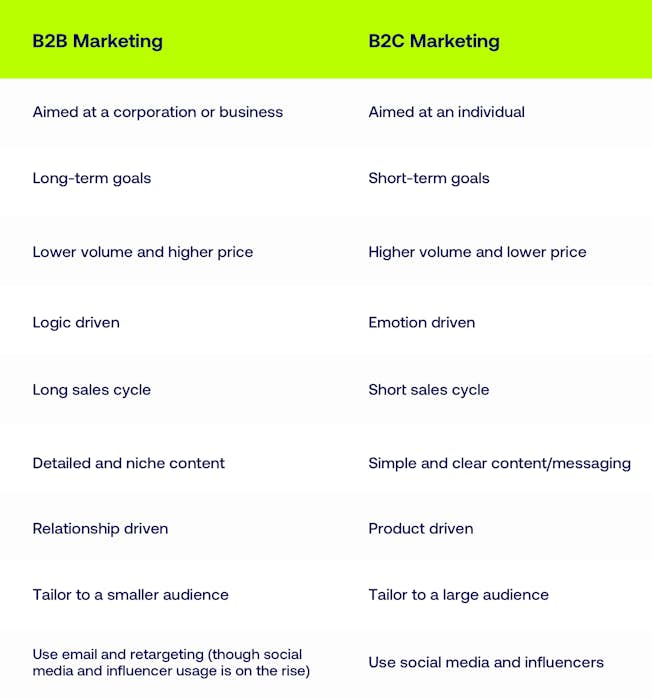
B2B Marketing Trends
B2B marketing is undergoing rapid change and is finding its normal after the Covid-19 pandemic when everything, and everyone, was forced to move online. So what are the trends to look out for in 2022 and beyond?
1. Omnichannel marketing
Due to the long sales cycle, B2B businesses need to connect with their audience across multiple channels. Omnichannel marketing enables the B2B sector to use a multi-pronged approach that not only provides different channels but enhances the customer experience and journey.
It’s important to know the difference between omnichannel marketing and multichannel. The image below from Dave Chaffey shows the various strategies and channels a business can use to reach a customer at various stages of the buying cycle. It demonstrates how complex the omnichannel journey can be but when done correctly can drive engagement, sales and revenue.
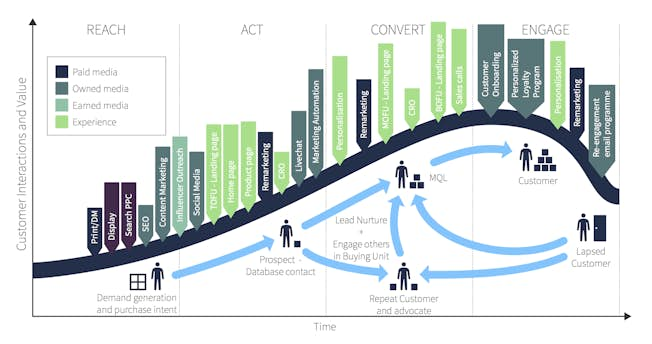
2. Influencer marketing
While influencer marketing is common for B2C brands, it has taken B2B brands a little longer to catch onto the strategy. It’s also a more complex process because B2B sales can involve multiple stakeholders so you need to find an influencer or influencers that can catch the eye of people in different roles.
But B2B influencer marketing is on the rise. ‘Growth Opportunities for Global B2B Influencer Marketing’ report found that B2B influencer marketing has the potential to generate $11.7 billion in revenue by the end of 2022, with more than 38% of B2B companies currently exploring it as a new lead-generation avenue.
The secret for B2B marketers is to find influencers with gravitas in a certain area. It’s not about finding a fresh new face or celebrity but someone who is an industry or thought leader. Think about authors or bloggers, researchers or popular podcast hosts/guests.
Download our Influencer Tracker Tool if you’re looking for a way to assess and keep track of your influencers.
3. Social media marketing
There’s an increase in B2B brands using social media and they’re not just on staple channels like LinkedIn and Facebook. Some well-known brands are making waves on the ever-popular platform TikTok to grab the attention of a young audience (more on that below!).
According to Deloitte’s 2021 CMO survey, B2B product brands will spend 14.7% of their marketing budget on social media into 2023. And that’s expected to increase by 10 points in the next 5 years.
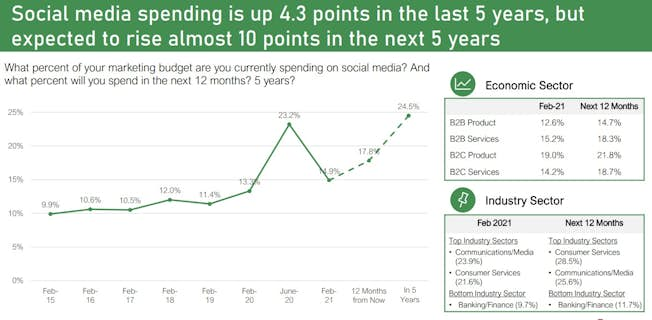
This growth demonstrates how successful social media can be for B2B products and services. However, it’s about choosing the right channels and using a variety of organic and paid content e.g. video, blogs, and downloadable assets to engage and convert.
4. Focus on ROI
Our survey on the state of marketing in 2022, ‘The Marketing Evolution: Leadership, Transformation, Skills, Challenges & the Future’, found that ROI is a big challenge for B2B and B2C businesses.
According to one VP of Marketing in Financial Services, the greatest challenges are: “Measuring marketing effectiveness in early stages for long stage B2B sales cycles and understanding the customer journey.”
While some metrics are easy to track, such as social media ROI, measuring the effectiveness across an entire B2B cycle from engagement to sale can be difficult. The key is to set KPIs that you can track and link back to an action such as a landing page conversion or download to give a lead conversion rate.
5. Sales are going digital
Gartner, in their Future of Sales analysis predicts that by 2025, 80 percent of B2B sales interactions will be digital while the majority of B2B organizations will use data-driven selling. That’s an enormous leap for B2B organizations that relied on face-to-face sales and traditional marketing tactics such as conferences and events.
At the heart of this is streamlining sales processes to have analytics and data embedded in the process. No more relying on business cards or brochures to drive leads and sales, it will be about communicating and servicing customers through online channels.
This will also help to drive the global trend of personalization and provide opportunities using new technologies such as machine learning and AI.
B2B Marketing Platforms
The best B2B marketing platforms are used for automation, managing social media, remote communication and meetings, video conferencing, SEO, market research, customer relationship management, website optimization, and email.
- Ahrefs - An all-in-one SEO toolset, Ahrefs can audit and optimize your website, analyze competitors, find relevant keywords, learn from your industry’s top-performing content and track your ranking progress. Check out our complete guide to Ahrefs.
- Marketo - Provides automation software for account-based marketing and other marketing services and products including content creation and SEO
- BuzzSumo - This allows you to see popular and trending content to help in your content creation and helps you find the most popular channels for content types and find top influencers in your area.
- Salesforce - A well-known B2B tool, Salesforce specializes in customer relationship management software and offers applications focused on sales, customer service, marketing automation, analytics, and app development
- Buffer - This helps to automate your social media posts across channels enabling you to schedule in advance and analyze performance.
- OptinMonster - This is a lead generation tool that helps you create website pop-ups and plugins to get more subscribers and capture data.
- Intercom - This is a business messaging tool that enables B2B brands to engage and chat with customers.
- Sprout Social - A social media management and intelligence tool that helps B2B brands measure follower growth, engagement, hashtag trends, and conversions.
- Chili Pepper - A suite of automated scheduling tools designed to help B2B teams convert more leads into qualified meetings integrated with a form scheduler that offers leads a way to book a meeting or start a phone call immediately after submitting a form.
- Hot Jar - Offers a powerful website tool that tracks user behavior and combines analysis and feedback to show you how to optimize your site to increase conversions.
- MailChimp - This tool is a marketing automation platform for managing mailing lists and creating email campaigns.
There are a lot of great B2B marketing platforms out there so optimize your processes by trying one or more of them.
B2B Content Marketing
Content marketing is an important part of B2B marketing and social selling. It helps to engage customers and move them along the sales funnel. According to the ‘11th Annual B2B Content Marketing Benchmarks, Budgets, and Trends’ report 83 percent of B2B content marketers use social media ads and promoted posts, up from 60 percent the previous year.
What’s important about content marketing is that you know the formats and types that work for your audience and at what stages. For example, a blog can be very useful for driving traffic to a site or landing page at the awareness stage. When it comes to the decision-making stage, a gated original report or ebook can drive a prospect over the line.
Check out our Tools & Templates for Successful Blog posts
Video content can be very successful for B2B marketing, particularly live webinars where customers can ask questions or discuss cutting-edge or trending topics. These can also be shared across social media channels to inform and engage particularly YouTube. Check out our blog on how to create a successful YouTube channel.
Types of B2B content that will help drive traffic and conversions are
- Videos
- Infographics
- Blogs
- Research reports or whitepapers
- Ebooks
- Podcasts
- Webinars
- Case studies and testimonials
- Newsletters
- Presentations
- Interviews
Read our blog ‘13 Amazing Examples of B2B Content Marketing’ for inspiration.
B2B Email Marketing
Another strand of content marketing that’s successful for B2B businesses is email marketing. 87 percent of B2B marketers say email is one of their top free organic distribution channels according to the Content Marketing Institute.
So why is it successful? When an email is crafted to be relevant to a particular audience that includes personalization to a targeted list, it’s highly effective in driving action and revenue: (the Direct Marketing Association found email’s ROI to be £38.33 for every £1 spent!)
B2B marketers can use email to engage a new prospect, offer subscribers up-to-date and relevant information, and re-engage lapsed customers with an offer or exclusive deal. It’s also great for building an engaged community through newsletters. This can help to identify clients that may be willing to share their stories or features in a case study to promote your B2B product or service to others.
A great example of B2B email marketing is from Packhelp, a custom packaging company. It uses eye-catching imagery for each block accompanied by concise text that appeals to different types of personas effectively. It also includes clear CTAs to drive click-through.
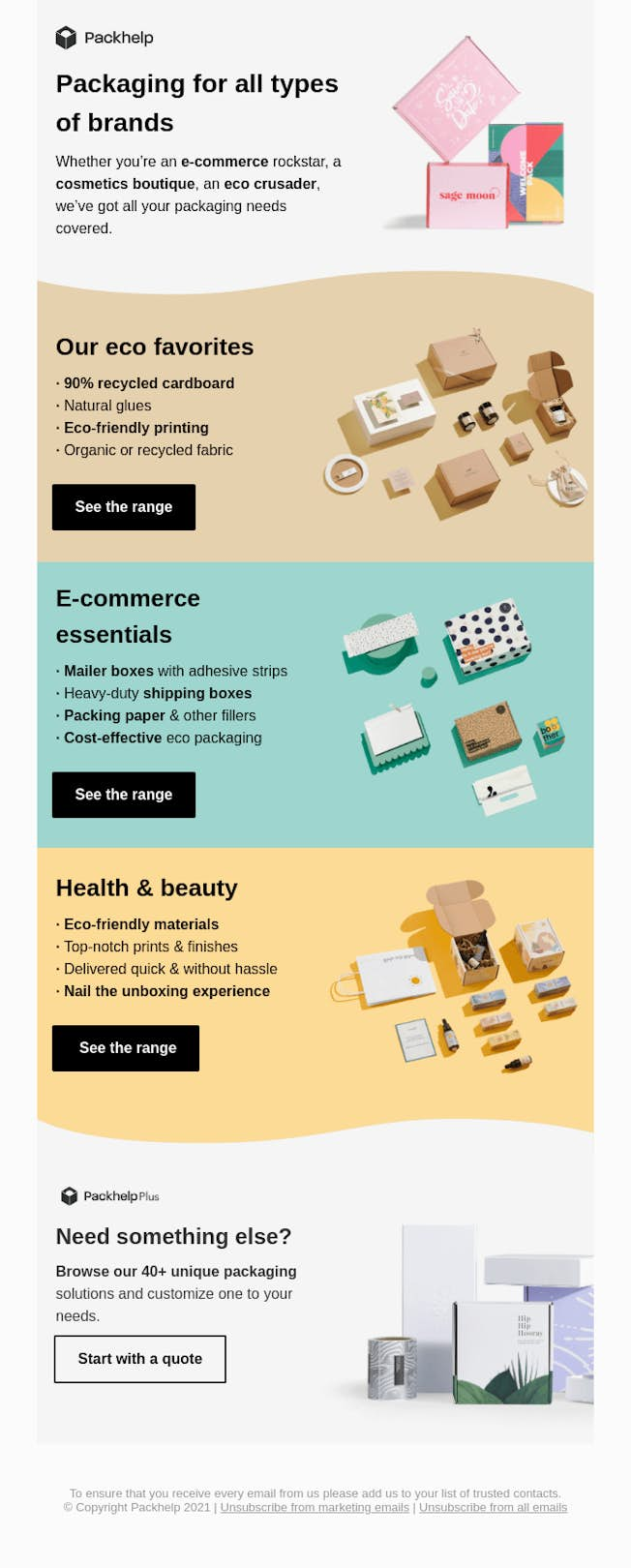
B2B Social Media Marketing
Social media - paid and organic - is very effective for B2B companies as a way to build brand awareness, build trust, and educate. Credibility is a determining factor for clients when deciding on a B2B company and social media offers a great opportunity to do that.
The 12th Annual B2B Content Marketing Report found that 45 percent of B2B marketers have increased their spending on paid social posts with LinkedIn, Facebook and YouTube giving the best results.
The key to social media is having a distinctive brand voice. Just because you are a B2B brand doesn’t mean it has to be serious or without life. A great example of this is CRM company Zendesk which uses humor to drive engagement like in this tweet.

Social media can also act as a great customer service channel to respond to customers' queries or complaints quickly. Increasingly B2B brands are using social platforms as another way to reach out and improve customer experience.
It can also be a way to communicate with your audience. Using polls or open-ended questions on a current topic can drive engagement and give you insights into your audience on a channel. Twitter is particularly good for this due to its real-time nature.
B2B brands can also use social media as employee advocacy and recruitment tools. Many brands now give a behind-the-scenes look at their company or promote a person within their teams to show what it’s like to work there. Take the language app Duolingo as an example of a video going viral as a result of the antics of their mascot - a large green owl.

The rise of social commerce now also presents new opportunities for brands to drive transactions on social platforms which may work for repeat customers.
B2B Marketing Strategies
There are many B2B marketing strategies you can use to engage customers. You can consider both paid and organic strategies so see what will suit your company as they will not all apply depending on your business and sector.
1) Create a website or ecommerce site - This will be the shop front of your business online so it should give information about your business, offer resources, enable a way to subscribe if you have a newsletter, and a way to contact your team.
2) Use content marketing and SEO - These techniques will help you to increase online visibility and drive traffic.
3) Use an omnichannel approach - Integrate your offline and online marketing activities so you can keep track of activities and measure performance.
4) Use PPC campaigns - Paid campaigns are a great way to target a specific audience and get your brand seen.
5) Leverage social media - Social media marketing works and can help to drive brand awareness and offer a customer service channel to serve existing customers. Create custom audiences to target personas.
6) Focus on first-party data - The demise of third-party cookies means that your first-party data is even more valuable so cultivate those email marketing lists.
7) Offer self-service options - Over 70 percent of B2B buyers prefer remote human interactions and digital self-service according to McKinsey, so consider offering some of these options like webchat.
B2B Marketing Examples
Let’s take a look at some B2B companies who are doing great things in their marketing campaigns and activities.
Let’s take a look at some B2B companies who are doing great things in their marketing campaigns and activities.
Smartsheet: smart use of social media
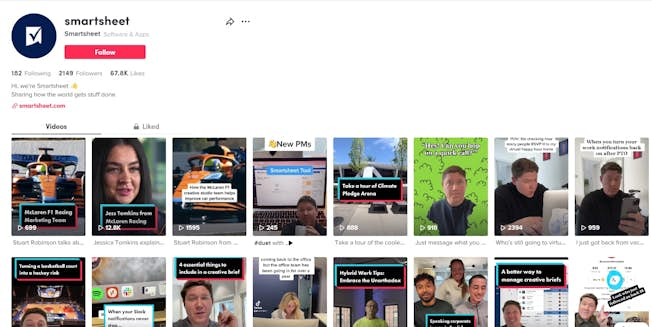
You wouldn’t expect a work management platform to rock TikTok, but Smartsheet does. The channel’s content is generated by employees across the business recruited by the social media team to give an insider view of what it’s like to work at the company and tutorials.
It also encourages user-generated content and engages with users on TikTok to drive visibility and engagement.
“TikTok gives you the ability to interact with your community in a bunch of different ways, including dueting and stitching videos,” says Brian Bosché, Director of Product Marketing at Smartsheet. “We love it when people create videos about Smartsheet and will duet and react to them pretty consistently. We commented on someone’s video about how they use Smartsheet, and they created another video about what they loved about Smartsheet as a response.”
Drift: leveraging the power of chat
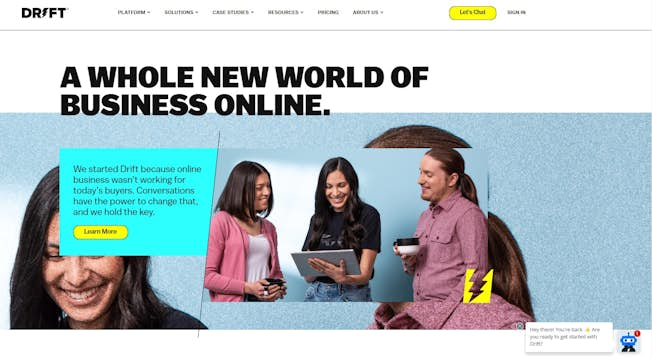
Conversational sales and marketing platform leader, Drift is no stranger to innovation. Rather than use lead generation forms, the company offers B2B businesses a way to capture data through web chat.
It adopted this approach itself and as a result, 63 percent of people who open the chat box on Drift’s pricing page chose to start a conversation with a sales rep. In comparison, its email campaigns generate click rates of 2-3 percent.
Adobe: focusing on content
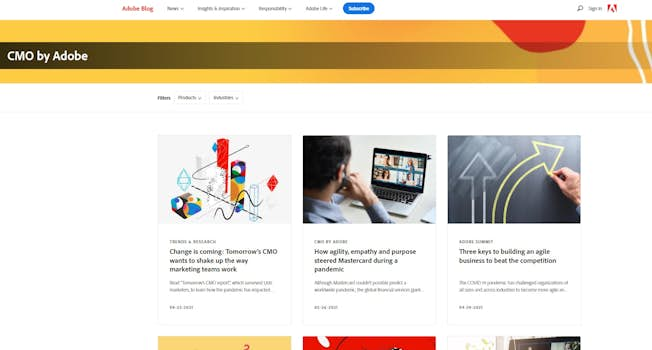
The multinational software company is a big player in the sector and is looked up to as an industry leader. One effective way they cemented this position is to make full use of content marketing by creating a specialized hub.
An early pioneer in this area, Adobe created a blog that now sees over one million visits every month, according to Similarweb. Its variety of content, from blogs to original research, can be sorted by category and sector. The ‘Insights and inspiration’ tab offers trends and insights that appeal to a senior executive audience.
Zoom: tapping into current events
One brand that saw users and revenue rocket during the coronavirus pandemic is the conferencing platform Zoom. The growth was such that at the end of 2020, the maximum number of daily meeting participants on Zoom was about 10 million. In March 2021, that figure reached more than 200 million daily meeting participants.
A victim of its own success, Zoom created a campaign ‘More than Meetings’ which showed the scope of the platform for use in work. Zoom also uses content creatively across social media channels and launched the ‘Virtual Background Contest’ on social selecting winners each month at the height of the pandemic in 2020.
Conclusion
As you can see there is huge scope for marketing as a B2B business with a wide variety of channels and strategies available. The key is to understand your business and audience so you can market to the right people at the right time in the right places.
Treat your B2B business in the same way any B2C marketer would do and experiment. Try small-scale A/B testing to compare messaging, try polls on social media to engage, and experiment with content types and brand voice. Often it’s something small that makes things click into place and sets your B2B business on a new path to drive brand awareness, customer engagement and leads.
Learn B2B Marketing Tips and Techniques
Drive business success by using one or all of the B2B marketing strategies outlined above. DMIs Professional Diploma in Digital Marketing will not only teach you the fundamentals of digital marketing but cover PPC, social media marketing, analytics, strategy, and much more. Sign up today to get started!
Related
Upgrade to Power Membership to continue
your access to thousands of articles, toolkits, podcasts, lessons and much much more.
Become a Power Member- Login
- View Courses
- - - -
- Courses
- Resources
- - - -
- My Account
- Change Password
- Logout





